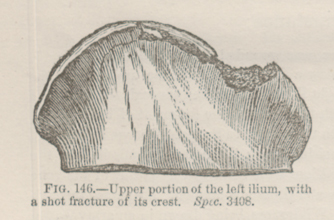Title: G——, D.
Source text: The Medical and Surgical History of the War of the Rebellion. (1861-65.), Part 2, Volume 2 (Washington, DC: Government Printing Office, 1876), 216.
Civil War Washington ID: med.d2e31905
TEI/XML: med.d2e31905.xml
CASE 631. Private D. G——, Co. F, 56th Pennsylvania, aged 38 years, was wounded at South Side Railroad, October 27, 1864, by a conoidal ball, which entered over the crest of the left ilium and emerged two inches to the right of the spinal column. He was sent to City Point, thence to Alexandria, Virginia, where he was admitted to hospital on November 2d. "He complained of severe pain; there was no paralysis either of sensation or of motion in the lower extremities, and he micturated freely. Water-dressings were applied, opiates administered, and a half diet with extras was allowed. A few days before the 13th, the patient had a chill, which was followed by fever, low muttering delirium, quick and feeble pulse, icteric hue of the skin, and breath of a saccharine odor. Supporting treatment was of no avail; he gradually grew worse, and died November 13, 1864. Noticeable at the post-mortem examination, thirty-four hours subsequently, were the great degree of rigidity, slight emaciation, suggillation posteriorly, and the fœtid odor of a dark, peculiar fluid emitted from the cancellated structure of the injured ilium. There was half an ounce of serum in the left pleura; the upper lobes of the left lung were congested posteriorly; the lower lobe congested and indurated, and portions of it splenified, with numerous abscesses the size of a millet-seed in its substance. The upper and lower lobe of the right lung were congested and indurated posteriorly, with an abscess the size of a pea and numerous smaller ones in their substance. The bronchi were inflamed; the pericardium contained two ounces of fluid, and there was a large yellow clot in the right auricle, which extended into the pulmonary veins. The omentum was thickened; the peritoneum drier than usual; the small intestines congested externally. Their surfaces felt clammy, and, in the left iliac region, they were slightly adherent to each other and to the lower part of the rectum by a few shreds of recently deposited lymph. The spleen and kidneys were paler than usual. The liver was paler than usual posteriorly, indurated and darker than usual anteriorly. The gall-bladder contained two ounces of very dark inspissated bile. The wounds did not penetrate the abdominal cavity, but on removing the descending colon suppuration was found to have extended to the outer coat of the intestine posteriorly." With the foregoing notes, Surgeon E. Bentley, U. S. V., contributed to the Museum a section of the injured ilium, which is represented in the adjacent figure (FIG. 146).
